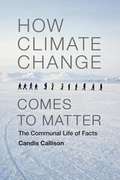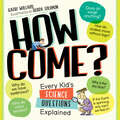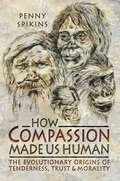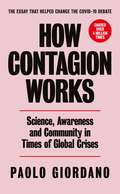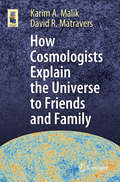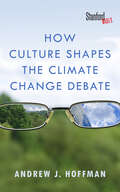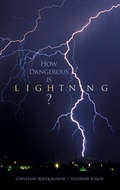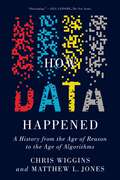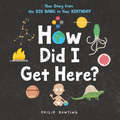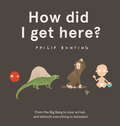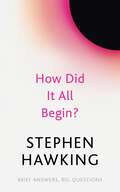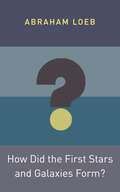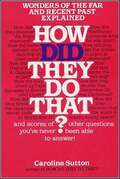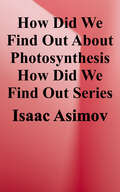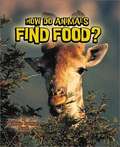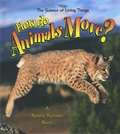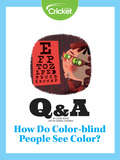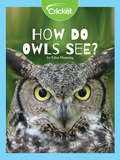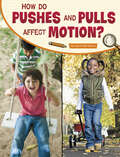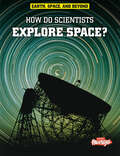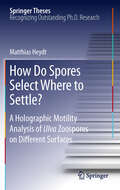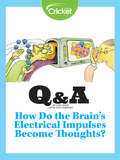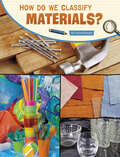- Table View
- List View
How Climate Change Comes to Matter: The Communal Life of Facts
by Candis CallisonDuring the past decade, skepticism about climate change has frustrated those seeking to engage broad publics and motivate them to take action on the issue. In this innovative ethnography, Candis Callison examines the initiatives of social and professional groups as they encourage diverse American publics to care about climate change. She explores the efforts of science journalists, scientists who have become expert voices for and about climate change, American evangelicals, Indigenous leaders, and advocates for corporate social responsibility.The disparate efforts of these groups illuminate the challenge of maintaining fidelity to scientific facts while transforming them into ethical and moral calls to action. Callison investigates the different vernaculars through which we understand and articulate our worlds, as well as the nuanced and pluralistic understandings of climate change evident in different forms of advocacy. As she demonstrates, climate change offers an opportunity to look deeply at how issues and problems that begin in a scientific context come to matter to wide publics, and to rethink emerging interactions among different kinds of knowledge and experience, evolving media landscapes, and claims to authority and expertise.
How Come?: Every Kid's Science Questions Explained
by Kathy WollardFact-filled, fun-filled, as interesting to parents as it is to kids, the How Come? series is the trusted source for lively, clear answers to kids’ science queries. Now the best questions and answers from all three books—How Come?; How Come? Planet Earth; and How Come? In the Neighborhood—have been revised, updated, freshly illustrated in full color, supplemented with twenty completely new questions, and combined into one bigger, better volume. How Come? explains, in fascinating detail, more than 200 mysteries and phenomena in the world around us. These are the questions that pique kids’ curiosity—and stump parents.When it rains, does running (rather than walking) to the nearest shelter really keep you any drier? How can a stone skip across a pond (instead of sink)? If the Earth is spinning, why can’t we feel it? Why don’t we fly off? Why do elephants have trunks? And the all-time classic, Why is the sky blue? (Sunlight has a hidden rainbow of colors, and air molecules scatter blues the most—sending bright blue light down to Earth.) The text is clearly written, engaging, and accessible. It’s for every kid who wants to know—and every grown-up who simply doesn’t know.
How Compassion Made Us Human: The Evolutionary Origins of Tenderness, Trust & Morality
by Penelope SpikinsAn intriguing look at how our capacity to care about and connect with others has contributed to our evolutionary success as a species. Our ability to care about the wellbeing of others, whether they are close family or strangers, can appear to be unimportant in today&’s competitive societies. But in this volume, archaeologist Penny Spikins argues that compassion lies at the heart of what makes us human. She takes us on a journey from the earliest Stone Age societies two million years ago to the lives of Neanderthals in Ice Age Europe, using archaeological evidence to illustrate the central role that emotional connections had in human evolution. Simple acts of kindness left to us from millions of years ago provide evidence for how social emotions and morality evolved, and how our capacity to reach out beyond ourselves into the lives of others allowed us to work together for a common good—and form the basis for human success.
How Contagion Works: Science, Awareness and Community in Times of Global Crises - The short essay that helped change the Covid-19 debate
by Paolo Giordano'Lucid, calm, informed, directly helpful in trying to think about where we are now... The literature of the time after begins here' Evening Standard'Taking a breather from bewildering statistics and terrible tales of contagion to read Giordano's book was a jolt of brevity and simplicity... It takes concepts that have been dancing away in our minds, just out of reach, and lines them up neatly' The Times'Potent and original' Sunday Times'In one short hour, in the midst of this difficult moment, Giordano reinforced my sense of hope in humanity, in the one and the many' Philippe Sands, author of East West Street and The Rat LineThe Covid-19 pandemic is the most significant health emergency of our time.Writing from Italy in lockdown, physicist and novelist Paolo Giordano explains how disease spreads in our interconnected world: why it mattershow it impacts ushow we must reactExpanding his focus to include other forms of contagion - from the environmental crisis to fake news and xenophobia - Giordano shows us not just how the coronavirus crisis got so bad so quickly, but also how we can work together to create change.Paolo Giordano is a physicist and the author of four bestselling novels. His article 'The Mathematics of Contagion' - published in Italy at the beginning of the coronavirus emergency - was shared more than 4 million times and helped shift public opinion in the early stages of the epidemic.
How Cosmologists Explain the Universe to Friends and Family (Astronomers' Universe)
by Karim A. Malik David R. MatraversThis fascinating book provides an accessible and up-to-date overview of modern cosmology. In particular, the book discusses the formation of the Cosmic Microwave Background and the evolution of large scale structures in the universe, the distribution of galaxies and clusters of galaxies on very large distance scales.Following a brief introduction, the authors describe the scientific method – how science is done. They then discuss observational cosmology, the instruments and what observations can be done with them, and what is derived from those observations. After discussing the constituents of the universe, including dark matter and dark energy, the authors provide an outline of the forces that shape the universe, with particular emphasis on gravitation. Following this, the reader is taken on a journey in time from the present day back to the very beginning of the universe, a period called inflation, which sets the initial conditions for the subsequent evolution of the universe. The book ends with a brief chapter on what lies beyond. Written by two experts, the book is aimed at the interested lay-person with little or no physics background, but an interest in modern cosmology.
How Culture Shapes the Climate Change Debate
by Andrew J. HoffmanThough the scientific community largely agrees that climate change is underway, debates about this issue remain fiercely polarized. These conversations have become a rhetorical contest, one where opposing sides try to achieve victory through playing on fear, distrust, and intolerance. At its heart, this split no longer concerns carbon dioxide, greenhouse gases, or climate modeling; rather, it is the product of contrasting, deeply entrenched worldviews. This brief examines what causes people to reject or accept the scientific consensus on climate change. Synthesizing evidence from sociology, psychology, and political science, Andrew J. Hoffman lays bare the opposing cultural lenses through which science is interpreted. He then extracts lessons from major cultural shifts in the past to engender a better understanding of the problem and motivate the public to take action. How Culture Shapes the Climate Change Debate makes a powerful case for a more scientifically literate public, a more socially engaged scientific community, and a more thoughtful mode of public discourse.
How Dangerous Is Lightning?
by Vladimir Rakov Christian BouquegneauLightning strikes somewhere on the surface of the earth about 100 times every second, and current observations indicate a significant increase in activity in the coming years. This illustrated survey explores the history of lightning, from ancient to modern times. Mythology and observations of lightning damage constituted the extent of lightning history until the Enlightenment period, when Benjamin Franklin, Thomas-François Dalibard, and others began applying a scientific approach. Detailed studies began at the dawn of the twentieth century, with the advent of modern instrumentation. This volume presents up-to-date views of thunderstorm clouds, lightning phenomenology and parameters, spatial distribution of lightning activity, and the global electric circuit. It explores the physical effects of lightning as well as secondary effects, lightning protection, and new frontiers in the understanding of lightning. An information-based study, this book is appropriate for classroom use as well as for popular science readers of all ages.
How Data Happened: A History from the Age of Reason to the Age of Algorithms
by Chris Wiggins Matthew L. Jones“Fascinating.” —Jill Lepore, The New Yorker A sweeping history of data and its technical, political, and ethical impact on our world. From facial recognition—capable of checking people into flights or identifying undocumented residents—to automated decision systems that inform who gets loans and who receives bail, each of us moves through a world determined by data-empowered algorithms. But these technologies didn’t just appear: they are part of a history that goes back centuries, from the census enshrined in the US Constitution to the birth of eugenics in Victorian Britain to the development of Google search. Expanding on the popular course they created at Columbia University, Chris Wiggins and Matthew L. Jones illuminate the ways in which data has long been used as a tool and a weapon in arguing for what is true, as well as a means of rearranging or defending power. They explore how data was created and curated, as well as how new mathematical and computational techniques developed to contend with that data serve to shape people, ideas, society, military operations, and economies. Although technology and mathematics are at its heart, the story of data ultimately concerns an unstable game among states, corporations, and people. How were new technical and scientific capabilities developed; who supported, advanced, or funded these capabilities or transitions; and how did they change who could do what, from what, and to whom? Wiggins and Jones focus on these questions as they trace data’s historical arc, and look to the future. By understanding the trajectory of data—where it has been and where it might yet go—Wiggins and Jones argue that we can understand how to bend it to ends that we collectively choose, with intentionality and purpose.
How Did I Get Here?: Your Story from the Big Bang to Your Birthday
by Philip BuntingFrom the Big Bang to your birthday, and (almost) everything in between, this funny and informative book tells your story.You are one of the newest members of a family tree that goes way, way, way back to the very first life on Earth. A lot of incredible things had to happen between the beginning of the universe and today in order to make you. The fact that you (and everyone you know) are here is nothing short of mind-boggling! Read this book to discover how it happened, and prepare to be amazed by the awesomeness of you.This clever, funny, and scientific timeline of the journey of human existence is designed to get young readers asking questions, finding answers, and marveling at the many wonders of our world, from the Big Bang, to evolution, to a brand-new baby, and more.
How Did I Get Here?
by Philip BuntingThis is the unathorised biography of you. Charting your incredible journey from Big Bang to birth (in about the time it takes to eat your breakfast), Philip Bunting's hilarious and one of a kind history of evolution was created to raise more questions than it answers. Perfect for fans of Jon Klassen and Chris Haughton.
How Did It All Begin? (Brief Answers, Big Questions)
by Stephen Hawking'Remember to look up at the stars and not down at your feet'How did it all begin?Is there a God?Throughout his extraordinary career, Stephen Hawking expanded our understanding of the universe and unravelled some of its greatest mysteries. In How Did It All Begin? the world famous cosmologist and bestselling author of A Brief History of Time explores the fundamental questions of our existence.'A brilliant mind' Daily TelegraphBrief Answers, Big Questions: this stunning paperback series offers electrifying essays from one of the greatest minds of our age, taken from the original text of the No. 1 bestselling Brief Answers to the Big Questions.
How Did the First Stars and Galaxies Form? (Princeton Frontiers in Physics #1)
by Abraham LoebA concise introduction to cosmology and how light first emerged in the universeThough astrophysicists have developed a theoretical framework for understanding how the first stars and galaxies formed, only now are we able to begin testing those theories with actual observations of the very distant, early universe. We are entering a new and exciting era of discovery that will advance the frontiers of knowledge, and this book couldn't be more timely. It covers all the basic concepts in cosmology, drawing on insights from an astronomer who has pioneered much of this research over the past two decades.Abraham Loeb starts from first principles, tracing the theoretical foundations of cosmology and carefully explaining the physics behind them. Topics include the gravitational growth of perturbations in an expanding universe, the abundance and properties of dark matter halos and galaxies, reionization, the observational methods used to detect the earliest galaxies and probe the diffuse gas between them—and much more.Cosmology seeks to solve the fundamental mystery of our cosmic origins. This book offers a succinct and accessible primer at a time when breathtaking technological advances promise a wealth of new observational data on the first stars and galaxies.Provides a concise introduction to cosmologyCovers all the basic conceptsGives an overview of the gravitational growth of perturbations in an expanding universeExplains the process of reionizationDescribes the observational methods used to detect the earliest galaxies
How Did They Do That?
by Caroline SuttonThe totally satisfying answers to more than 100 questions that drive normal people—not to mention infomaniacs and trivia buffs—crazy.Questions about matters great and small, from ancient times to yesterday.Illustrated with illuminating technical drawings and unusual vintage photographs.How did they spend $40 million making Heaven's Gate?How did they decide the length of a mile?How did Beethoven compose when he was deaf?How did they discover the Hope diamond?How did they know the size of the Earth over 1,700 years before anyone sailed around it?How did they set the price of the Louisiana Purchase?How did the FBI devise the "Ten Most Wanted" list?How did they decide which horses were Thoroughbreds?How did they pick the Four Hundred?How did they start the Guiness Book of World Records?How did the Indians decide that cows were sacred?How did they discover penicillin?How did they build the Great Pyramid at Giza?How did they decide how tall to make the Empire State Building?How did they know there was an El Dorado?How did they start the Chicago fire of 1871?How did Hannibal cross the Alps?
How Did We Find Out About Photosynthesis? (How Did We Find Out About…)
by Isaac AsimovTraces the scientific discoveries that led to our understanding of photosynthesis and how this process relates to the food supply, changing ecological balance, and threats to the Earth's atmosphere.
How Do Animals Find Food?
by Bobbie KalmanWith so many species competing for food, animals have developed fascinating methods of finding the food that keeps them fat and happy. How do animals find food? Lets children in on such techniques as pack and solitary hunting, and poisonous animals.
How Do Animals Move?
by Bobbie Kalman Niki WalkerSlithering snakes, jumping kangaroos, flying albatrosses, and swimming salmon--every animal, including humans, has its own unique way of getting around. This beautiful new book explains the how, why, and "are we there yet?" of animals large and small across the globe. Topics include: *how an animal's environment affects its movement *how an animal's skeleton affects its movement *unusual animal movers such as the water-walking basilisk *how a parent helps its young move around
How Do Apples Grow (Lets read-and-find-out Science #Stage 2)
by Betsy MaestroDescribes the life cycle of an apple from its initial appearance as a spring bud to that point in time when it becomes a fully ripe fruit.
How Do Color-blind People See Color?
by Lizzie WadeTo understand what it means to be color-blind, you must first understand how most of us see color.
How Do Owls See?
by Edna ManningOwl eyes function much like human eyes but with some small differences.
How Do Pushes and Pulls Affect Motion? (Science Inquiry)
by Lisa M. SimonsYou push your friend while they swing. You pull open a door. What happens when you push or pull an object? Let’s investigate pushing and pulling forces!
How Do Spores Select Where to Settle?
by Matthias HeydtIn this thesis, Matthias Heydt applies digital in-line holography to achieve for the first time a complete three dimensional and real time motion analysis of Ulva zoospores, both in solution and in the vicinity of different surfaces. These results provide previously unknown information about the behavior and mechanism spores use to select a suitable site for settlement. This work gives deeper insight into biofouling algae and stimulates new design strategies for antifouling coatings. Furthermore, the tracking system developed during this research could be used as a new system for assessing the antifouling performance on different surfaces at very early points in time, allowing disentanglement of surface conditioning and interaction of spores with pristine chemistries.
How Do the Brain's Electrical Impulses Become Thoughts?
by Lizzie WadeHow do brain impulses translate into a state of mind? This Q & A explores the science of the brain and gives an insight into feelings and abilities.
How Do We Classify Materials? (Science Inquiry)
by Yvonne PearsonScientists put things into groups so they are easier to study. Materials have different properties. What are they, and how they are grouped? Let’s investigate materials!
How Do We Know What Information Sharing Is Really Worth?: Exploring Methodologies to Measure the Value of Information Sharing and Fusion Efforts
by Brian A. JacksonHow Do We Know What Information Sharing Is Really Worth?: Exporing Methodologies to Measure the Value of Information Sharing and Fusion Efforts (Research Reports)
